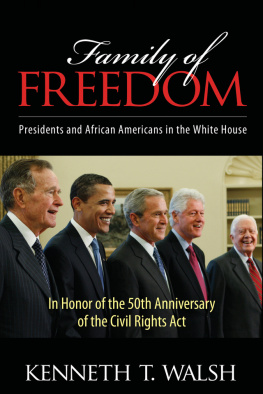The Columbia Guide to African American History Since 1939
COLUMBIA GUIDES TO AMERICAN HISTORY AND CULTURES
Columbia Guides to American History and Cultures
Michael Kort,
The Columbia Guide to the Cold War
Catherine Clinton and Christine Lunardini,
The Columbia Guide to American Women in the Nineteenth Century
David Farber and Beth Bailey, editors,
The Columbia Guide to America in the 1960s
David L. Anderson,
The Columbia Guide to the Vietnam War
The Columbia Guide to African American History Since 1939
Edited by Robert L. Harris Jr. and Rosalyn Terborg-Penn
COLUMBIA UNIVERSITY PRESS
NEW YORK
Columbia University Press
Publishers Since 1893
New York Chichester, West Sussex
cup.columbia.edu
Copyright 2006 Columbia University Press
All rights reserved
E-ISBN 978-0-231-51087-5
Library of Congress Cataloging-in-Publication Data
The Columbia guide to African American history since 1939 / edited by Robert L.
Harris Jr. and Rosalyn Terborg-Penn.
p. cm.(Columbia guides to American history and cultures)
Includes bibliographical references and index.
ISBN 0-231-13810-5 (alk. paper) 1. African AmericansHistory18771964. 2. African AmericansHistory1964
I. Harris, Robert L., 1943II. Terborg-Penn, Rosalyn. III. Series.
E185.6.C715 2006
973'.0496073dc22
2005034370
A Columbia University Press E-book.
CUP would be pleased to hear about your reading experience with this e-book at .
For
Anita, Lisa, Leslie, and Lauren
and
Jeanna C.T. Penn
CONTENTS
This guide introduces a general audience to the contours of the African American past since 1939 and serves as a reference for students and scholars to the major themes, events, and persons that dramatize the story. provides a historical narrative that acquaints readers with four chief time frames and that gives them a context within which to place central developments of the post-1939 African American experience. It begins by exploring approaches to the study, interpretation, and teaching of African American history from World War II to the present. African American history began to take on a life of its own after 1939 as black people became more active in the struggle for freedom, justice, and equality and as the nation confronted the contradiction between advocating democracy abroad while practicing racial discrimination and segregation at home. This contradiction stood out in bold relief in 1939, a watershed year in African American history, when some 75,000 Americans, black and white, attended a concert by Marian Anderson on the steps of the Lincoln Memorial in Washington, D.C., after the Daughters of the American Revolution refused to rent its Constitution Hall for her performance. Millions more heard the concert on radio and became aware of the irony that the worlds greatest contralto had to perform outdoors because of racial bigotry and discrimination, even as the nation criticized Nazi Germany for its practice of fascism and white supremacy.
Historians have used several approaches to make sense of the African American past, such as revisionist, contributionist, vindicationist, and Afrocentric interpretations. With the triumph of the civil rights movement, scholars broadened their study to include issues of class, sexuality, color, gender, religion, region, and profession. They have begun to probe the multidimensionality of the black population in the United States in ways that were not possible when African Americans had to project a united front against racial subordination. In the process, African American history has become richer, more varied and nuanced in texture.
Readers can use the historical narrative as a guide to the unfolding of African American history since 1939 and as a means of identifying the major issues that black people confronted in their drive for racial equality. They will become familiar with the need for different movements to address those concerns. Moreover, they will begin to understand why the movements took shape and their strengths as well as their weaknesses. Readers will be in a better position to determine for themselves the efficacy of strategies for change. They will realize the differences between the desires of local communities for change and the programs of national organizations. The African American journey since 1939 is much more than the story of a few brave men and women. Although figures such as Ella Baker, Mary McLeod Bethune, Jesse Jackson, Martin Luther King Jr., Malcolm X, Thurgood Marshall, Rosa Parks, A. Philip Randolph, and Eleanor Roosevelt loom large in the story, they were representatives of countless black and white unnamed and often unrecognized participants in the movement.
The present juncture in African American history is much more complex than in the past, with a larger black immigrant population, with the black and white dichotomy being complicated by the growing Asian and Latino populations, and with the irony of a sizeable black middle class but the persistence of a huge black underclass. The historical narrative identifies and explains these developments as well as issues such as affirmative action, police brutality, and the drive for reparations.
examines some of the key themes for understanding African American history since 1939. Essays in this section explore cultural and political issues of self-designation from colored, Negro, Afro-American, and black to African American, as well as the unsettled aspects of what people of African ancestry in the United States should call themselves at the beginning of the twenty-first century. The postindustrial era since World War II, marked by a decline in manufacturing jobs and the rise of new technologies, has shifted the ground of racial inequality in this country and the best means to address the problem. The military has become both a means for black advancement in American societyespecially for black women, who outnumber white women in the armed forcesand a model of greater opportunity for African Americans. Although today African Americans dominate some of the major sports, such as boxing, basketball, football, and track and field, the slow process of desegregation there is still being played out at the management level. Similar to sports, African American literature, art, theater, film, and music have moved more into the mainstream since World War II and have reflected the changing nature of African American and American society. Black business development has also shifted from a traditional black consumer base to a broader market, especially in music and advanced technology.
Each of the thought-provoking essays in gives them the specific components that add greater meaning to the whole. In each instance, readers can use the material as a reference to understand the African American past in its different dimensions. They can learn for the first time about certain events and developments, verify information, or refresh their memories.
The chronology in , a substantial resource guide to textbooks, general references, military records, and materials on some of the major events and eras, such as desegregation of the military, the civil rights movement, black nationalism, urban riots and rebellions, postcivil rights, and the decades of the 1980s and 1990s. The resource guide identifies manuscript collections; film, video, and recordings; libraries, museums, and historical sites; and newspapers, periodicals, and Web sites. Most of the materials are annotated to introduce the reader to the resources and their significance.






